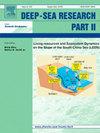Uncovering the hidden amphipod biodiversity and its drivers in the Persian Gulf
IF 3
3区 地球科学
Q2 OCEANOGRAPHY
Deep-sea Research Part Ii-topical Studies in Oceanography
Pub Date : 2025-02-10
DOI:10.1016/j.dsr2.2025.105463
引用次数: 0
Abstract
The Persian Gulf (PG), an epicontinental sea at the northwestern corner of the Indian Ocean presents a challenging environment in which species confront the upper limits of their environmental tolerance. Previous hypotheses suggested that the PG is a homogeneous ecosystem characterized by low species diversity and a limited number of endemic species. We investigated these hypotheses by studying the amphipods' distribution pattern and environmental drivers, a dominant benthic group in the PG. We compiled an extensive database of amphipod distribution by integrating the open-access data including the Ocean Biodiversity Information System (OBIS) and Global Biodiversity Information Facility (GBIF), literature mining on amphipods, as well as the author's sampling database from the Persian Gulf and the Gulf of Oman. Following careful data cleaning and quality control, the final dataset comprised 1411 distribution records of 134 accepted marine amphipod species collected from depths ranging from 0 to 100 m. The environmental variables were extracted from the Bio-ORACLE database for the benthic layer with the maximum depth. Species richness per hexagonal cells (alpha species richness), and ES15 (expected number of species per 15 random samples) were calculated. Our findings revealed higher-than-expected species richness and non-homogeneous amphipod distribution across the region. Two biodiversity hotspots were identified in the northern and northwestern parts of the PG and a lowspot of amphipod species diversity in the southern half. Beta diversity cluster analysis exhibited three distinct compositions of amphipod assemblages: a northwestern community near the Arvand (Shat AL-Arab) river, a northern assemblage along Iranian coasts and the Strait of Hormuz region, and a southern assemblage along Arabian coasts. Generalized Additive Models (GAMs) and General Linear Models (GLMs) outputs showed that all environmental variables, pH, and temperature were the most important drivers in delimiting the benthic species distributions and richness. Our findings emphasize the need for a detailed approach to understanding the distribution and diversity of marine organisms in the PG where data and knowledge are less shared openly. This region should not be treated as a homogeneous ecosystem, as it harbors many endemic and rare species threatened by anthropogenic activities such as oil extraction and ocean warming.
揭示隐藏在波斯湾的片足类生物多样性及其驱动因素
波斯湾(PG)是印度洋西北角的一个大陆外海,呈现出一个具有挑战性的环境,在这个环境中,物种面临着环境耐受力的上限。以往的假设认为,青藏高原是一个物种多样性低、特有物种数量有限的同质生态系统。作者利用海洋生物多样性信息系统(OBIS)和全球生物多样性信息设施(GBIF)等开放获取的数据,结合作者在波斯湾和阿曼湾的采样数据库,建立了一个广泛的片足类分布数据库,并对片足类的分布格局和环境驱动因素进行了研究。经过仔细的数据清理和质量控制,最终数据集包括从0至100米深度收集的134种可接受的海洋片足类动物的1411条分布记录。从Bio-ORACLE数据库中提取最大深度底栖层的环境变量。计算了每六边形细胞的物种丰富度(α物种丰富度)和ES15(每15个随机样本的期望物种数)。结果表明,该地区片足类物种丰富度高于预期,且分布不均。在青藏高原北部和西北部发现了两个生物多样性热点,而在南半部发现了片足类物种多样性的低点。β多样性聚类分析显示了三种不同的片脚类组合:西北部靠近Arvand (Shat AL-Arab)河的群落,北部沿伊朗海岸和霍尔木兹海峡地区的群落,以及南部沿阿拉伯海岸的群落。广义加性模型(GAMs)和广义线性模型(GLMs)的结果表明,pH和温度是影响底栖生物物种分布和丰富度的最重要因素。我们的研究结果强调需要一种详细的方法来了解PG中海洋生物的分布和多样性,因为数据和知识很少公开共享。该地区不应被视为一个单一的生态系统,因为它拥有许多受到石油开采和海洋变暖等人为活动威胁的特有和稀有物种。
本文章由计算机程序翻译,如有差异,请以英文原文为准。
求助全文
约1分钟内获得全文
求助全文
来源期刊
CiteScore
6.40
自引率
16.70%
发文量
115
审稿时长
3 months
期刊介绍:
Deep-Sea Research Part II: Topical Studies in Oceanography publishes topical issues from the many international and interdisciplinary projects which are undertaken in oceanography. Besides these special issues from projects, the journal publishes collections of papers presented at conferences. The special issues regularly have electronic annexes of non-text material (numerical data, images, images, video, etc.) which are published with the special issues in ScienceDirect. Deep-Sea Research Part II was split off as a separate journal devoted to topical issues in 1993. Its companion journal Deep-Sea Research Part I: Oceanographic Research Papers, publishes the regular research papers in this area.

 求助内容:
求助内容: 应助结果提醒方式:
应助结果提醒方式:


